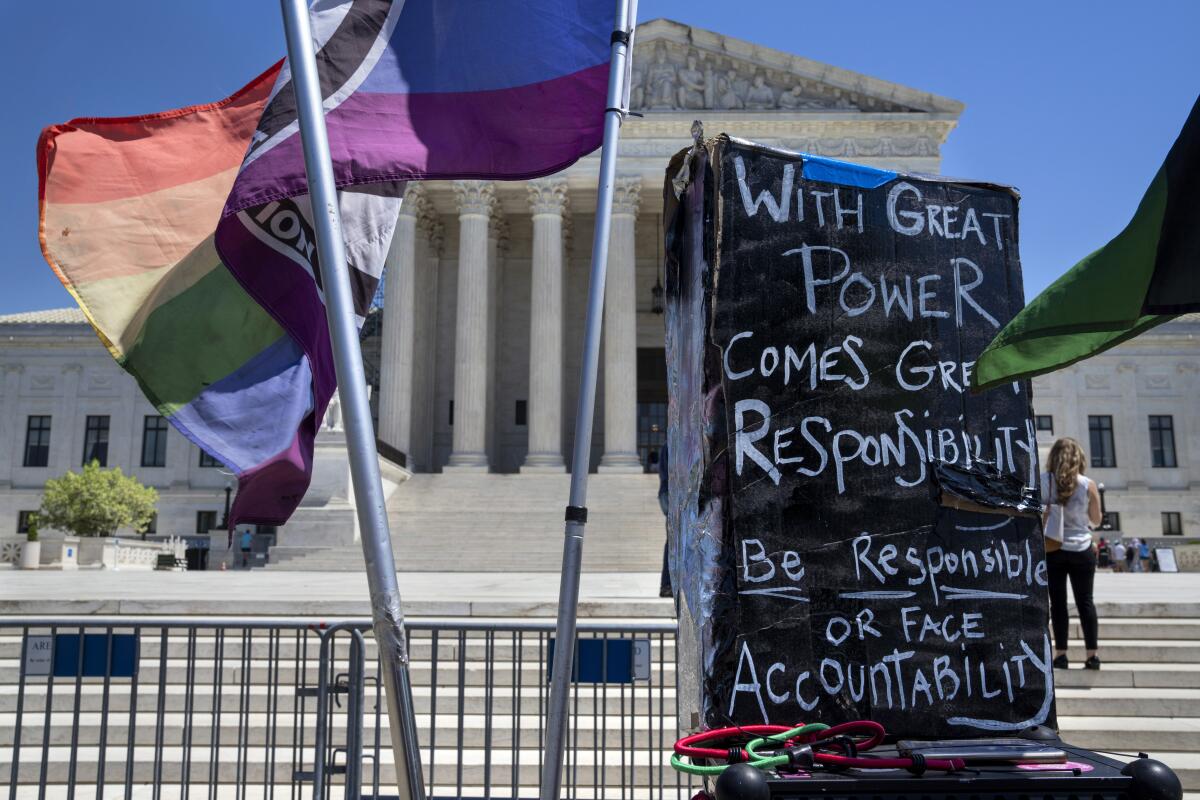What the Supreme Court’s abortion pill case could mean for California

- Share via
Lee had just been dumped when she found out she was pregnant.
With no car, no job and no support, the 23-year-old — who asked that her last name be withheld for medical privacy — ended up at the virtual clinic Hey Jane, where she was quickly assessed and prescribed abortion medication.
Four months later, thousands of Californians in a similar situation have been holding their breath as the U.S. Supreme Court weighed a case that could rewrite the rules of care in more than two-thirds of U.S. abortions, limiting access to a popular drug even in states where it remains legal.
The justices voiced clear doubts about a lower court’s decision to overrule the Food and Drug Administration and restrict mifepristone — the first in a two-drug protocol that now accounts for 63% of all legal abortions in the United States — signaling they are unlikely to restore byzantine rules for prescribing the medication.
“Do we have to also entertain your argument that no one else ... in America should have this drug in order to protect your clients?” Justice Ketanji Brown Jackson said in a pointed exchange later echoed by her frequent rival Justice Neil M. Gorsuch.
But advocates in California say even if the current rules are left in place, the case represents a growing threat to reproductive rights in “sanctuary” states — particularly as legal challenges target telehealth, which has risen to account for 16% of U.S. abortions since 2021.
These numbers do not include the roughly 6,000 abortions estimated to take place outside the formal medical system each month, the overwhelming majority of them likewise induced by a combination of mifepristone and misoprostol procured through the mail, according to a study this week in the medical journal JAMA.
“I’m concerned that people don’t realize how important telehealth is — it’s a major pillar in the abortion care landscape,” said professor Ushma Upadhyay of UC San Francisco, a reproductive healthcare expert. “People don’t understand how important it could become in the future.”
‘Bewildering, surprising and unexpected’
The court’s ruling on mifepristone is not expected until June. The reason the stakes are high is that unlike the decision in Dobbs vs. Jackson Women’s Health Organization, which overturned Roe vs. Wade in 2022, a Supreme Court ruling to restrict the drug would roll back a series of important changes to the way it is prescribed and dispensed nationwide.
Care that can currently be delivered by a nurse-midwife via a brief video call or online questionnaire would revert to a time-consuming and costly series of clinic visits with a physician. Medication abortion could be offered for only 49 days from the start of a patient’s last period, instead of up to 10 weeks as it is today. Those changes would also bar mifepristone prescriptions through telehealth, leaving some to rely on a less effective regimen with more unpleasant side effects.
Telehealth is the only viable option for patients who can’t take a sick day, find a babysitter — data from the Centers for Disease Control and Prevention show the lion’s share of abortion patients are already mothers — or catch a ride to a clinic that may be hours away on public transit, experts say.
“I’ve had patients tell me, ‘I’ve got a job that won’t let me take time off. I’ve got kids and no child care,’” said Dr. Michele Gomez of the MYA Network, a consortium of virtual providers, who has served many patients with Medi-Cal. “Lots of people talk to me while they’re at work. I’ve had so many people [take appointments] with their kids crawling all over them.”
Women who have relied on the medication say it felt like the most convenient — and safest — option.
“I knew the clinic locations, but actually getting there was hard,” Lee said of her abortion. “It all felt so scary, on top of having to be in the situation.”
Gomez said that in years past doctors were required to watch patients take the pill. Eliminating those and other rules helped propel medication abortion from the margins of care to the heart of reproductive rights within the last decade, the Bay Area provider and others said.
“I can send [pills] out by mail any time it works for me,” she said.
The changes also paved the way for clinicians in California and five other states to prescribe and mail abortion medication to patients in jurisdictions where it’s been banned, under so-called shield laws.
“Abortion care via mail is now the most viable form of access for most of the country,” said Kiki Freedman, co-founder and chief executive of Hey Jane, an abortion telehealth startup. “Any change to the way mifepristone is prescribed is an attack on access, period.”
Indeed, a growing number of experts believe the rise of telehealth could explain why abortions jumped in the wake of the Dobbs decision, even as 21 states have partially or completely outlawed the procedure.
“This is bewildering, surprising and unexpected — we expected the numbers to drop,” said Upadhyay. “There’s a lot of unmet need being met through telehealth.”
‘Half the patients I see are sitting in their car’
The meteoric rise of medication abortion is part of the reason antiabortion activists have gone to such pains to get rid of it, many say.
“Telehealth abortion is worrisome to that side because they know that it is safe and it is effective and people can end pregnancies on their own,” said Michele Goodwin, a law professor at UC Irvine and an expert on reproductive justice. “That’s threatening to them.”
Medication abortion using mifepriestone was already cheaper, faster and easier to access than vacuum aspiration and other in-clinic procedures when telehealth became available under emergency pandemic rules in 2020.
But it became radically more accessible and less expensive in 2021, as virtual providers including Hey Jane, Abortion on Demand and 145 Abortion Telemedicine established themselves alongside brick-and-mortar clinics under the FDA’s new guidance.
And more clinicians felt called to offer it in 2022, as state bans pushed abortion seekers to neighboring states, stretching wait times at in-person clinics in Colorado, Illinois and Kansas, where an in-clinic appointment can take weeks to secure.
“Even before the Dobbs decision, I asked myself, what can I do?” said Dr. Stephanie Colantonio, a Los Angeles-based pediatrician who began providing care in 2021. “It was really meaningful to me that I would be able to offer this to people.”
California has also moved to make care more accessible, though barriers remain. Medi-Cal covers about half of all abortions in the state — almost the same as the proportion of births it pays for — but billing for telehealth is still novel, and few providers can do it.
“California only recently updated the law to cover telehealth for abortion last year,” said Upadhyay. “For most [Medi-Cal] patients, they have to decide, do I want free abortion or do I want to pay and get telehealth?”
That decision is often fraught.
“We see a lot of patients on lunch breaks,” said Leah Coplon, a nurse-midwife and director of clinical operations at Abortion on Demand. “I feel like half the patients I see are sitting in their car.”
‘In the comfort of my own home’
Seeking pills through the mail can also be the only physically accessible option for disabled abortion-seekers.
“The disability community is very concerned about this, because this could result in complete denials of care,” said Jillian MacLeod, reproductive justice legal fellow at the Disability Rights Education & Defense Fund, which filed a brief in support of telehealth abortion.
Still others say telehealth simply feels safer to them.
“I wanted to be able to do it in the comfort of my own home,” said Charlie Ann Max, a Los Angeles model who took the pills earlier this year. “It felt the most safe.”
With mifepristone under threat, some providers are looking at alternatives that would keep telehealth available to those who need it most. Many say that would mean prescribing only the second drug in the protocol, misoprostol, which is used to induce labor as well as for pregnancy termination.
“That would be the backup,” said Dr. Jayaram Brindala of 145 Telehealth. “It’s not ideal clinically, but still a good option for people who are in the first 13 weeks.”
Gomez agreed. “It’s very effective, but it’s not what I would recommend for my sister or my best friend or my daughter,” the doctor said.
Last year, Gov. Gavin Newsom announced California would stockpile the drug to maintain an emergency supply.
“Those who oppose abortion access have made it clear that they will not stop seeking new ways to roll back access and abortion rights across the country,” state Atty. Gen. Rob Bonta said.
His Department of Justice will use “every tool” at its disposal to keep California a haven for reproductive healthcare, he said.
“No matter what happens in the mifepristone case in the Supreme Court, it’s not going to be the end of our fight,” Bonta said.
More to Read
Sign up for Essential California
The most important California stories and recommendations in your inbox every morning.
You may occasionally receive promotional content from the Los Angeles Times.











